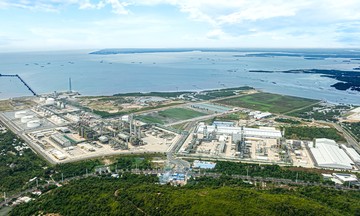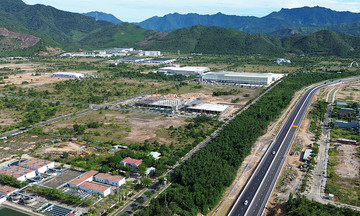Vietnam currently has nearly 1 million businesses. 98% of these are small and medium-sized enterprises (SMEs), contributing almost 50% of the national GDP. The government has many policies to support SME development, focusing on innovation, digital transformation, green transformation, increased technology application, and development of new business models.
AI is considered a feasible and effective technology for this group as it can support many stages in the process, increasing productivity and competitiveness. However, hundreds of thousands of businesses are still struggling with AI application due to concerns about capital, human resources, infrastructure, and data.
To help address this issue, Dr. Le Hung Cuong, Deputy General Director of FPT Digital - FPT Corporation, shared with VnExpress the importance of AI, how technology can support, and the roadmap SMEs can apply with a "small but effective" model.
Starting small to avoid being overwhelmed
How can businesses know where they are on their AI journey to apply the right strategy?
Assessing a business's current position is crucial to avoid "following the AI trend" without creating real value. The five levels of AI maturity model serve as a positioning map, helping businesses self-identify.
Specifically, level 1 is Awareness. Businesses are just starting to get acquainted with AI, perhaps experimenting with tools like ChatGPT or some basic chatbots. AI is not yet integrated into processes, and there are no metrics to measure effectiveness. This is the "knowing but not acting" stage.
Level 2 is Proactive. Some departments have proactively incorporated AI into specific tasks, such as marketing using AI for content creation or human resources using AI for applicant screening. However, the application lacks a company-wide synchronized strategy.
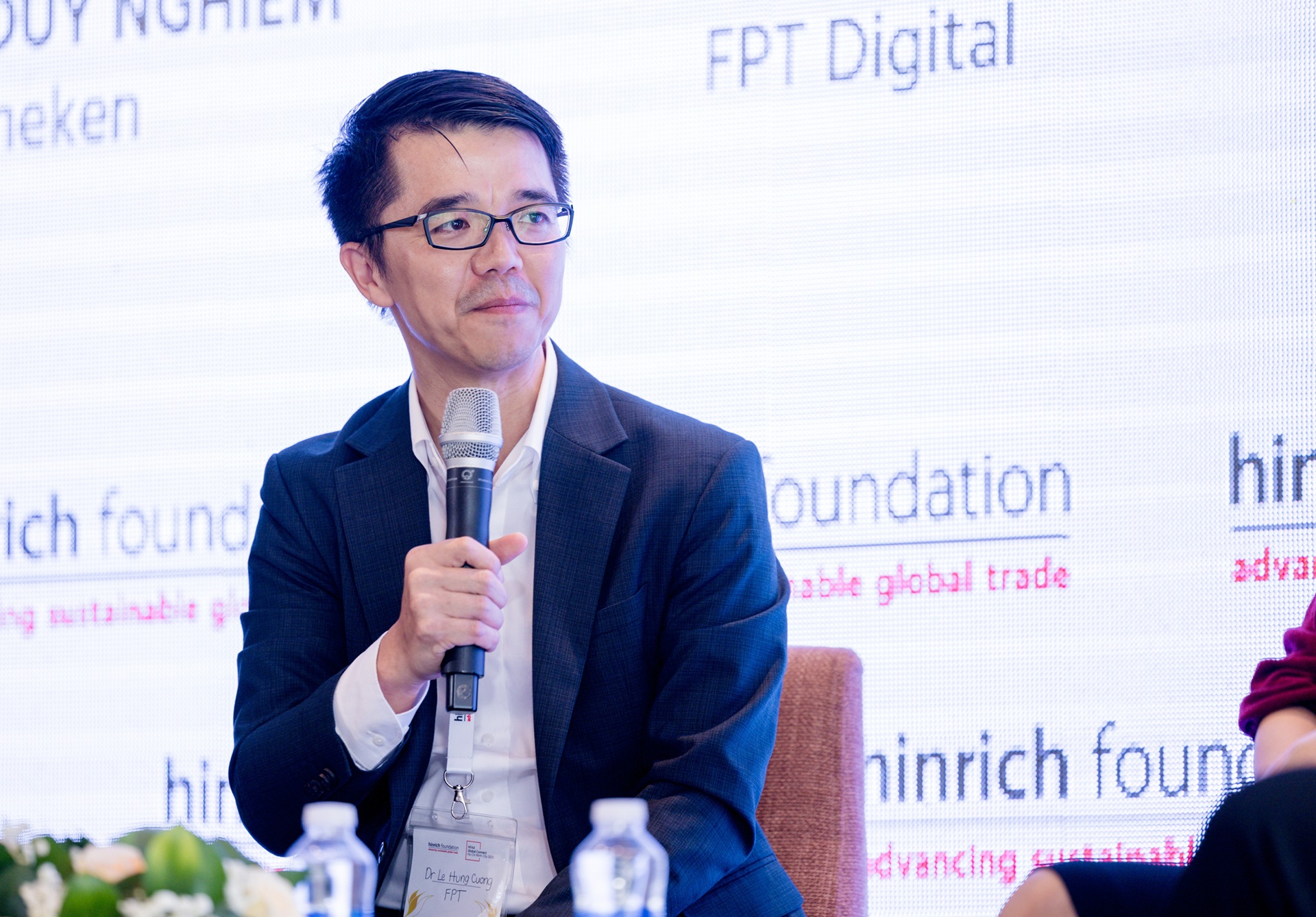 |
Dr. Le Hung Cuong, Deputy General Director of FPT Digital - FPT Corporation. Photo: NVCC |
Dr. Le Hung Cuong, Deputy General Director of FPT Digital - FPT Corporation. Photo: NVCC
Next is level 3, Operational. At this stage, AI begins to be integrated into official processes, with application guidelines (AI Playbook) and ROI measurement. For example, by using AI, a department reduces data processing time by 30% or increases sales productivity by 20%.
Level 4 is Systematization, where AI becomes part of the operational structure. There are guidelines, policies, and a shared AI culture. Specialized solutions and AI Agents work in coordination between departments.
Finally, level 5 is Full Transformation, the ultimate goal, where AI supports operations, creates new business methods, innovates products, accesses new markets, and makes strategic decisions in real-time.
If starting from level 1, how should the AI implementation roadmap begin?
This is a very practical and important question. SMEs have limited resources and can easily be overwhelmed by the "grand" AI models of large corporations.
In reality, AI is not just for "big players." AI implementation can start small but must be accurate, fast, and deliver real value.
The roadmap for SMEs, in our opinion, should start with AI Quick Wins – simple, easy-to-implement applications like ChatGPT for writing sales content, processing emails, creating automated care scenarios, or using AI to support recruitment and CV analysis. These are tasks that even non-technical office staff can perform with a little guidance.
 |
Businesses can apply ChatGPT to basic stages like writing advertising content, fanpage posts, and generating sales ideas. Photo: Pexels |
Businesses can apply ChatGPT to basic stages like writing advertising content, fanpage posts, and generating sales ideas. Photo: Pexels
With initial results, businesses can move on to standardizing processes. Repetitive, time-consuming tasks can be transformed into "AI-powered processes."
Next, if the business has data, even simple data from CRM, Excel, or available software, it can move towards medium-term AI solutions such as customer behavior analysis, order forecasting, and employee performance evaluation. These models can be deployed as SaaS (Software as a Service), without the need for complex infrastructure investments, while ensuring scalability as the business grows.
The highest level is long-term AI, also known as "difficult AI." This is the stage where AI is no longer a support tool but becomes part of the operational architecture, a platform for restructuring the business model or building a competitive advantage. Typical examples include AI Agents forecasting market demand in real-time, digital assistants supporting strategic decision-making, or user behavior analysis systems to automatically optimize customer experience with each interaction. These applications often require large data, robust infrastructure, and a specialized technical team, with implementation times ranging from 9 months to 2 years.
Most importantly, SMEs need to think clearly that it's not about "doing everything," but about "doing the right things and doing enough." There's no need to build a data center or recruit a team of dozens of AI specialists. Instead, identify one or two bottlenecks in the process, use AI to thoroughly address them, create concrete results, and from there, spread it throughout the organization.
AI for SMEs is not a scaled-down version of AI for large corporations, but a lean, practical strategy with measurable results.
Also from the most basic level, what is the minimum team structure that can help an SME begin its AI journey?
This issue is not about quantity but about clear roles and coordination. SMEs do not need to build a large AI team, but only a core group, for example, 3-5 people, responsible for three main capabilities: understanding the business, understanding technology, and having the ability to connect and execute.
The first and most important person is someone who "understands the problem" – usually a department manager or experienced operations staff. They don't need to know programming but must understand where the workflow is having problems, how it can be improved, and how AI can help.
 |
SMEs can start their AI transformation with a small team of 3-5 staff. Photo: Pexels |
SMEs can start their AI transformation with a small team of 3-5 staff. Photo: Pexels
The second person is someone who "knows the tools" – it could be internal IT, or even a young employee passionate about technology, familiar with common AI tools like ChatGPT, Claude, Gemini, Copilot, Notion AI, etc. They know how to effectively use available platforms to create specific solutions, from drafting content and processing data to automating reports.
The third person should play the role of "strategic bridge," which could be a department head or directly from the board of directors. They help ensure that the AI application is not a standalone effort but is aligned with business direction and scalable. When leaders are directly involved, the team will have a voice and receive support from other departments.
Another principle of effective organization is to integrate AI into specific processes. This means the core team should choose a simple, clear process (e.g., customer care, report synthesis, sending sales information) and then incorporate AI to create rapid change. When one process is successful, other departments will follow – and the spread will be natural, without coercion.
Can you give specific examples of how to apply the strategy at each level mentioned above?
We have had the opportunity to work with many Vietnamese businesses and have witnessed many success stories. A typical example comes from the retail sector. Initially, AI was applied to simple tasks such as creating advertising content and analyzing customer sentiment on social networks. But then, the business gradually moved towards building AI Use Cases – digital assistants that can synthesize market information, advise on sales programs in real-time, and even participate in data analysis to propose adjustments to the business strategy.
What matters is not just technology, but the change in thinking and work culture. Employees must start their work by asking AI, based on data, and then combine creativity to produce better results. Thanks to this, decision-making speed increases, and work processing time decreases by 40-50%. The rate of internal and customer interaction increases significantly.
In the manufacturing sector, we work with businesses to standardize end-to-end processes, train core teams, and develop appropriate AI Playbooks for each factory and department. From there, applications such as forecasting component demand, optimizing machine maintenance schedules, or analyzing product defects based on image data have been successfully implemented.
The common point in all these projects is not a large budget or the most advanced technology, but the commitment from leadership and the consensus from the team in changing old working methods with new approaches. When a business dares to choose AI as a starting point, dares to let technology reshape the process – that's when real transformation begins.
AI robot application model in stores and supermarkets. Photo: Thi Ha
A ready mindset makes it easy to apply new technologies
The above are the steps to practice, so what do SMEs need to prepare before practicing?
In our opinion, AI transformation does not start with technology, but with mindset. In practical consulting projects, we see that no matter how advanced the technology is, it cannot create value if the leadership team and staff are not ready to trust and exploit it properly. Many organizations have failed when they thought of AI as just software or a tool, instead of part of a long-term operational strategy.
Building an "AI-First" mindset helps Vietnamese businesses move faster. Instead of investing in infrastructure, businesses can start by changing their thinking and working methods. Especially with the popularity of ChatGPT, Gemini, DeepSeek, etc. When the mindset is ready, all subsequent technology applications become easier and more directed. AI is not just a tool but a new mindset to lead the organization into the future.
You mentioned changing the mindset of leaders. So, what is the biggest challenge in persuading senior leaders of a business to shift and place AI as the "backbone" of the strategy?
Many business leaders view AI from a "technical support" perspective, rather than as a platform for operational and business model innovation. Some are hesitant because they don't see a clear ROI or don't have a concrete vision of the role technology will play. This is the first barrier: lack of belief in the ability of AI to create practical value.
Besides, the "fear of change" mentality is also very common when they are used to the current management system, operating based on personal experience or models that have been effective in the past. With AI, they are forced to switch to a new management approach, making decisions based on data, automated analysis, and significantly faster decision-making speed. This requires a shift in organizational culture.
Leaders use AI first, then the organization transforms. That is the principle we always emphasize in every transformation project.
 |
Users leverage AI to create video content. Photo: Nguyen Tat Kiem
Many businesses are "stuck" in the pilot or localized application stage without being able to scale up. In your opinion, what is the core reason?
I think the biggest reason comes from the lack of an overall strategy and a culture that is not ready for transformation.
Many organizations start with very high expectations but approach it in a "single combat" manner, meaning experimenting with tools in a few departments without a consistent strategic connection. And without standard processes and inter-departmental coordination, successful experiments are still very difficult to scale.
Organizational culture is also a barrier. If only a few small groups actively apply AI while the rest are passive or even "resistant," AI will not be able to go far. In other words, AI is not limited by technology – but by consensus in thinking and action.
Businesses can refer to how to solve this problem with the "standardize to spread" approach that FPT Digital is applying. There are three key factors:
First, standardize the application process through the AI Playbook system – clear process templates, templates, and guidelines for each task and department. This helps businesses avoid "starting from scratch" in each unit and can reuse existing good practices.
Second, focus on building an internal "AI fire spreading" team. By training core teams in departments, those who not only know how to use AI but also know how to re-teach, inspire, and explain to colleagues.
Third, we encourage businesses to choose to implement use cases that connect multiple departments – such as AI Agent analyzing customer data to serve marketing, sales, and after-sales care.
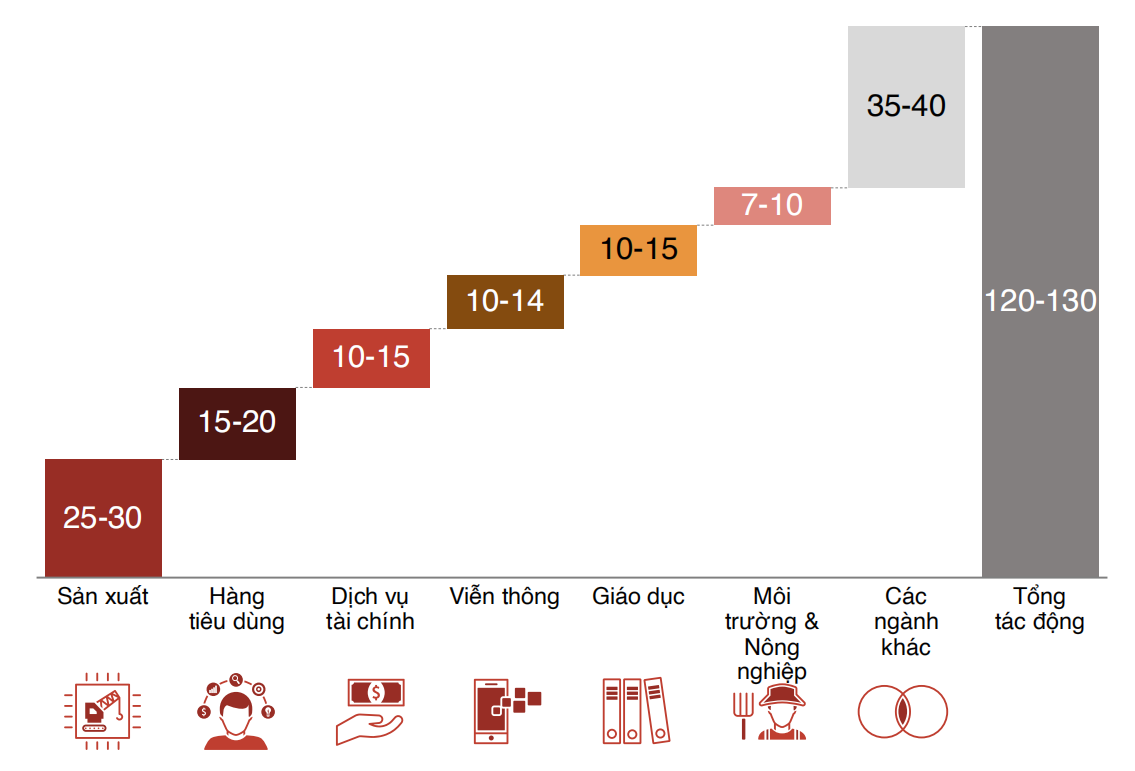 |
Estimated impact of AI on industries with a total value that could reach 130 billion USD by 2040. Source: NIC
Towards full AI automation
In what direction will the trend of AI application in Vietnamese businesses develop in the next 3-5 years?
In the next 3 to 5 years, I believe that AI application in Vietnamese businesses will shift significantly from the "tool experimentation" phase to restructuring processes and operational models using AI. Two prominent trends will shape the future: Workflow Automation and Agentic AI (digital assistant systems capable of autonomous action according to objectives).
But in the coming time, with the rapid development of generative models and foundational AI, businesses will have the capacity to fully automate an end-to-end process, from data entry, analysis, and decision-making to feedback actions. This saves time and helps eliminate bottlenecks in operations, especially with repetitive and data-driven processes.
Agentic AI will be a revolutionary step forward. These are AI Agents that can automatically track goals, suggest actions, and even coordinate with each other to complete tasks. For example, an AI Agent can monitor sales, detect early declines, automatically analyze causes from CRM data, and suggest appropriate promotional campaigns to send to customers – all happening almost without human intervention. When AI Agents are connected to operating systems – from ERP and CRM to analytics systems – businesses can achieve "intelligent automated operation" instead of just pure automation.
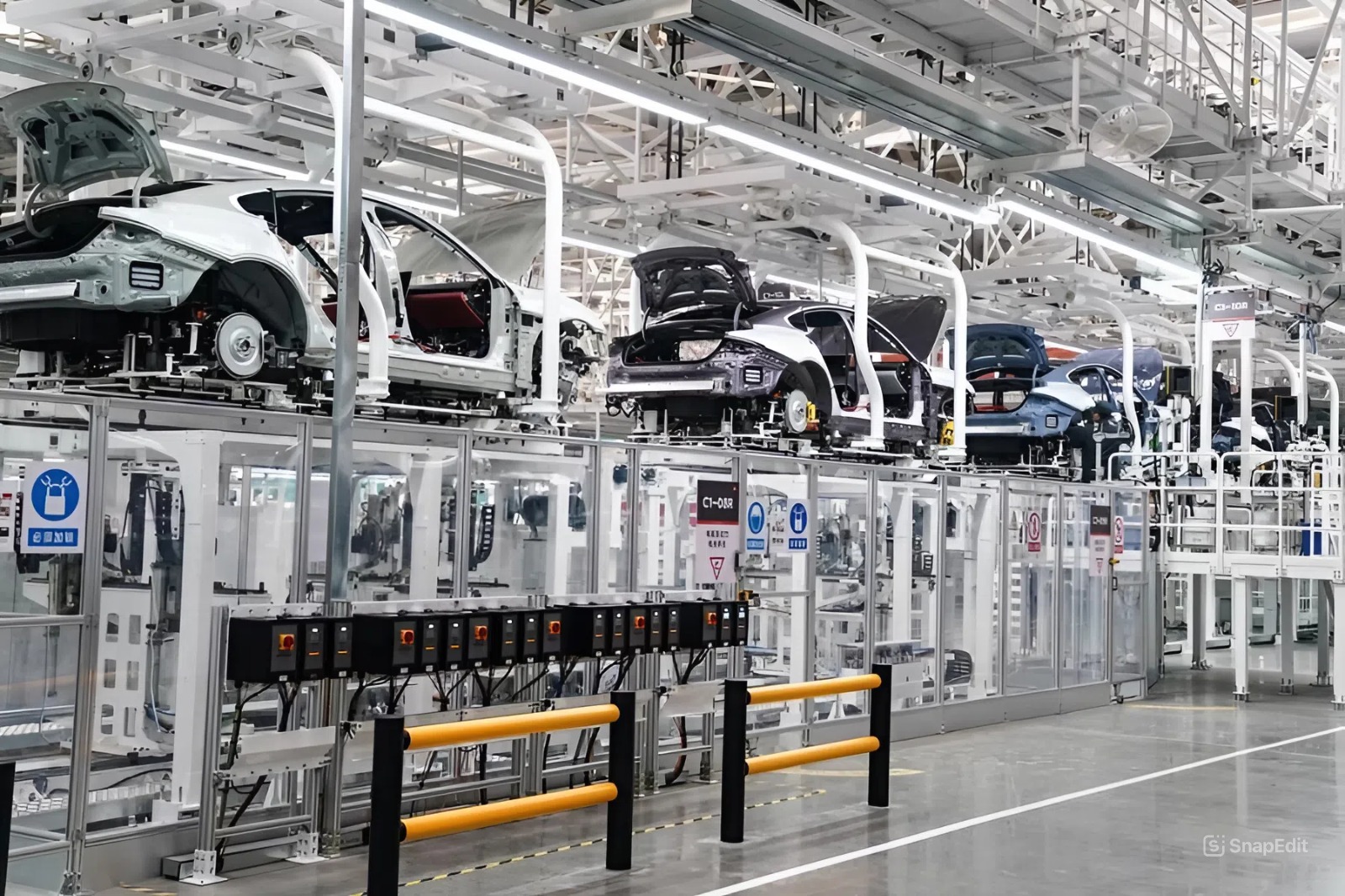 |
Xiaomi's car factory is deserted thanks to the application of robots, AI, and automation up to 91%. Photo: Xinhua
So, technology is changing very quickly. If they don't transform, what "competitive gaps" will Vietnamese SMEs face?
If Vietnamese SMEs do not begin their AI transformation journey in the next 1-2 years, the competitive gap will not just be a risk – it will be a very clear reality. And the worry is not being left behind by "big players" with technological potential, but being overtaken by competitors in the same industry who have applied AI systematically, leanly, and effectively.
The first gap is the speed of market response. While AI-powered businesses can make decisions in a few hours, thanks to automated analysis dashboards, 24/7 customer support chatbots, or AI synthesizing market trends in real-time, manually operated businesses will take several days, even a week.
The second gap is productivity and operating costs. A technology-applying business can reduce direct personnel costs by 30-40%, shortening response times from a few hours to a few minutes. A business using AI to write marketing content, automate quotes, or process orders can also save 50% of employees' working time. Meanwhile, SMEs without AI will continue to have to recruit more people, increasing costs but not significantly improving efficiency.
The most dangerous gap, in my opinion, is the gap in innovation capacity. AI is a source of inspiration for businesses to create new products, new distribution channels, and new operating models. Businesses that dare to incorporate this tool into their processes will understand customers better, optimize the experience journey, and from there, can "pivot" quickly when the market changes. Conversely, SMEs lacking a foundation will be stuck in old ways of doing things – difficult to adapt, difficult to expand.
If SMEs do not act now, the competitive gap will no longer be a matter of "if," but "when will they be overtaken." In a world where AI is increasingly prevalent, slow means missing opportunities.
The good news is that SMEs don't have to do everything at once. Just starting with a small process, choosing the right place for AI to create quick results, then transformation will no longer be a distant story.
Hoai Phuong






